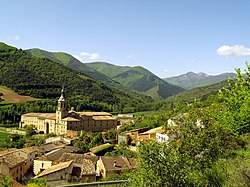world.wikisort.org - Spain
San Millán de la Cogolla (Spanish pronunciation: [san miˈʎan de la koˈɣoʎa]) is a sparsely populated municipality in La Rioja, (Spain). The village is famous for its twin monasteries, Yuso and Suso (Monasterio de San Millán de Yuso and Monasterio de San Millán de Suso), which were declared a World Heritage Site in 1997. There were 293 inhabitants registered in 2009, the population having fallen significantly during the twentieth century.
San Millán de la Cogolla | |
|---|---|
Municipality | |
 | |
 San Millán de la Cogolla Location in La Rioja  San Millán de la Cogolla Location in Spain | |
| Coordinates: 42°10′N 2°52′W | |
| Country | |
| Autonomous community | |
| Province | La Rioja |
| Comarca | Nájera |
| Government | |
| • Mayor | María Pilar Mendoza Martínez (PSOE) |
| Area | |
| • Total | 31.19 km2 (12.04 sq mi) |
| Elevation | 728 m (2,388 ft) |
| Population (2018)[1] | |
| • Total | 222 |
| • Density | 7.1/km2 (18/sq mi) |
| Demonym | Emilianenses |
| Time zone | UTC+1 (CET) |
| • Summer (DST) | UTC+2 (CEST) |
| Postal code | 26326 |
| Website | http://www.sanmillandelacogolla.es |
San Millán has a claim to being the birthplace of the Spanish language.[2] The area is Spanish-speaking but some of the local place-names are of Basque origin, and there is evidence that Basque was spoken locally a thousand years ago (see Glosas Emilianenses).
Jews were living here as early as at Nájera, and they suffered greatly in the civil war between Peter of Castile and Henry II of Castile. On October 15, 1369, at the request of the directors of the small aljama of San Millán, whose cause was advocated by "certain Jews who were received at court," Henry II of Castile ordered that "the Christian men and women and the Moorish men and women" should immediately discharge all their debts to the Jews, "that the last-named might be able to pay their taxes the more promptly." On September 10, 1371, however, the king released the abbot and all the monks of San Millán from whatever debts they had contracted with the Jews since the Battle of Nájera.[3]
Etymology
In a papal bull from 1199 where Privileges were granted to the monasteries of San Millán de la Cogolla it appears with the name Coculla, which comes from the Latin word cuculla, small hill, hilltop; this word is typically used for high sites and those of defensive nature, coming from the times of the Reconquista.[4] The other part of the name is taken from a 6th-century saint (Saint Emilianus or San Millán) who lived here.
Politics
| Term | Name of Mayor | Political Party |
|---|---|---|
| 1979–1983 | Santiago Lerena Alesanco | UCD |
| 1983–1987 | Santiago Lerena Alesanco | AP |
| 1987–1991 | Millán Ángel Baltanás Lorenzo | PSOE |
| 1991–1995 | Millán Ángel Baltanás Lorenzo | PSOE |
| 1995–1999 | Eladio Cañas Ureta | PR |
| 1999–2003 | Eladio Cañas Ureta | PP |
| 2003–2007 | Eladio Cañas Ureta | PP |
| 2007–2011 | María Pilar Mendoza Martínez | PSOE |
| 2011–2015 | María Pilar Mendoza Martínez | PSOE |
| 2015–2019 | Raquel Fernández Tejerina | PP |
| 2019– | n/d | n/d |
Notable people
- Juan de San Millán
- Antonio Segura
- María de la O Lejárraga
- Leandro Nieto Bolandier
- Joaquín Peña
- Tarsicio Lejárraga
See also
- Aurea of San Millán
- Monasteries of San Millán
References
- Municipal Register of Spain 2018. National Statistics Institute.
- San Millán Foundation
- http://www.jewishencyclopedia.com/view.jsp?artid=215&letter=S&search=san%20millan [bare URL]
- Ranz Yubero, José Antonio; López de los Mozos, José Ramón (2002). "Topónimos riojanos del patrimonio emilianense en una bula de 1199. (Archivo de San Millán M. 41-52)". Berceo (in Spanish) (142): 65–76. ISSN 0210-8550.
External links
- Official website of the monastery of San Millán
- Explore the San Millán Yuso and Suso Monasteries (La Rioja, Spain) in the UNESCO collection on Google Arts and Culture
- The Art of medieval Spain, A.D. 500-1200, an exhibition catalog from The Metropolitan Museum of Art Libraries (fully available online as PDF), which contains material on San Millán de la Cogolla (see index)
На других языках
[de] San Millán de la Cogolla
San Millán de la Cogolla ist eine spanische Gemeinde in der Autonomen Gemeinschaft La Rioja. Sie liegt am Fuße der Sierra de la Demanda im Tal des Cárdenas, einem Zufluss des Najerilla.[2]- [en] San Millán de la Cogolla
[es] San Millán de la Cogolla
San Millán de la Cogolla es un municipio de la comunidad autónoma de La Rioja en España. Está ubicado al pie de la sierra de la Demanda (sistema Ibérico) en la vertiente oriental que separa la Meseta del valle del Ebro, a 728 metros de altitud sobre el nivel del mar y a orillas del río Cárdenas.[ru] Сан-Мильян-де-ла-Коголья
Сан-Мильян-де-ла-Коголья (исп. San Millán de la Cogolla) — муниципалитет в Испании, входит в провинцию Риоха в составе автономного сообщества Риоха (Логроньо). Муниципалитет находится в составе района (комарки) Ангияно. Занимает площадь 31,19 км². Население — 278 человек (на 2010 год). Расстояние до административного центра провинции — 19 км.Другой контент может иметь иную лицензию. Перед использованием материалов сайта WikiSort.org внимательно изучите правила лицензирования конкретных элементов наполнения сайта.
WikiSort.org - проект по пересортировке и дополнению контента Википедии

